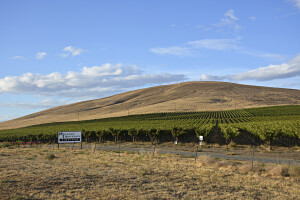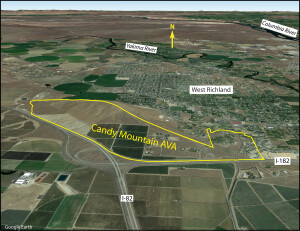
Photo of the Candy Mountain Vineyard by Kevin Pogue (provided by the Washington State Wine Commission)
On September 24, 2020, the TTB (Alcohol and Tobacco Tax and Trade Bureau) of the United States approved the Candy Mountain AVA. When this new AVA comes into force—on October 26, 2020—the total number of AVAs in the United States will be 251, of which 16 will be in Washington State.
Candy Mountain, located to the southeast of the Red Mountain AVA, is now the smallest AVA in Washington State (an honor previously held by Red Mountain). The new AVA lies entirely within the existing Yakima Valley AVA; however, the boundaries of the Yakima Valley AVA had to be expanded by 72 acres in order to make this possible. (This expansion was part of the approval process of the new AVA, and part of the “Final Rule” as published by the TTB.)

Map of the Candy Mountain AVA via Google Earth and Heather Bradshaw (provided by the Washington State Wine Commission)
The Candy Mountain AVA covers a total of 815 acres, with just over 110 acres currently planted to vines. There are two commercial vineyards—Candy Mountain Vineyard and Kitzke Cellars—in the area; Kitzke Cellars is a bonded winery specializing in Bordeaux-style blends. Plans for another bonded winery as well as an additional 200 acres of vines are in the works.
Candy Mountain is part of a chain of four small mountains in the area which includes Red Mountain, Badger Mountain, and Little Badger Mountain (all are part of the larger Yakima Fold Belt). The vineyards of the Candy Mountain AVA are on the mountain’s southwest-facing slope, on an incline that ranges from 2° to 20°. The soils are mainly thin, well-drained loess (wind-blown) silt atop basalt bedrock. The vines are planted at elevations ranging from 640 to 1,360 feet above sea level. This is a warm, windy area; and rainfall is meager—sometimes as little as 6 to 8 inches per year.
The leading grapes of the appellation include Cabernet Sauvignon, Merlot, Cabernet Franc, Sangiovese, and Syrah.
Welcome to the world, Candy Mountain AVA!
References/for more information:
- Final Rule – Establishment of the Candy Mountain AVA and Expansion of the Yakima Valley AVA
- TTB Docket for Candy Mountain
- https://www.washingtonwine.org/wine/facts-and-stats/regions-and-avas/candy-mountain
Post authored by Jane A. Nickles…your blog administrator: jnickles@societyofwineeducators.org